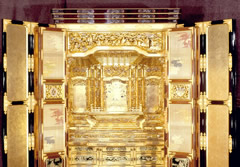MIKAWA Butsudan (Household Buddhist Altars)

Mikawa household Buddhist altars date back to the middle of the 18th century, when a craftsman constructed an altar from pine, cedar and cypress wood and finished it with lacquer from trees at the foot of Mt. Sarunage.
Gradually, more and more such artisans came to Okazaki, leading to the formation of a production center in the heart of the Mikawa area that still exists today.
A feature of Mikawa household altars is their low stands, which makes them easy to use. The uneri-nageshi style also means that the beautiful inner sanctuary is clearly visible. Using time-honored skills and techniques, these altars are richly decorated using natural lacquer, engraving, metal fittings, maki-e gold-sprinkled lacquer designs and gold leaf.
Feature
Mikawa household Buddhist altars are easy to use because their stands are set low. Traditional decorative techniques include lacquering, engraving, metal fittings, gold- and silver-sprinkled lacquer designs, gold leaf and more. Additionally, a method called uneri-nageshi ensures that the beautiful inner sanctuary is clearly visible.
How to make
Mikawa household altars are made by eight specialist craftsmen, each handling one aspect of the construction: preparing the wood, building the inner sanctuary, engraving, lacquering, applying the maki-e gold- or silver-sprinkled lacquer decorations, gold leafing, fashioning the metal fittings, and assembling the final product.

